Design is not the only factor of consideration when building or remodeling your kitchen. At a point in time, you have to consider kitchen faucets. Kitchen faucets are a must in the kitchen, and there are different types to choose from.
However, regardless of the type you choose, all faucets are designed for the same primary purpose. This purpose is to provide running water for dishes, hand-washing, and preparation of food. That said, there is also the added benefit of adding to the stylish appearance of the kitchen.
Before deciding which faucet fixture is right for your kitchen, you must be aware of the various and popular types available to you. You must also weigh the pros and cons associated with each because you want to choose the right one that will work for your kitchen for years.
So, whether you are building a new kitchen, remodeling an old one, or just want to learn about them. Here are the different types of kitchen faucets explained with pros and cons. Let’s get started.
Types of kitchen faucets
1. One-handle faucet
The one-handle faucet is one of the most common types of kitchen faucets. It consists of one handle or operation mechanism; it can either be turned side to side or up and down to control the temperature and the water flow. Although this faucet type has seen many design medications or alterations, it has stuck around for good reasons.
Pros
- Simple installation, even for DIY enthusiasts with basic tools and supplies.
- Affordable
- Easy operation
- Work great in tight spaces or small sinks
Cons
- Handle might experience wear and tear from usage
- Can be difficult to get a precise temperature or water flow
- Not as flexible as other types of kitchen faucets
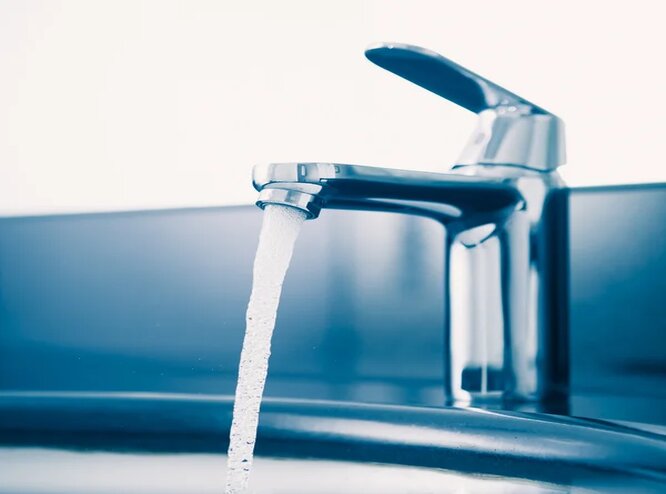
2. Double-handle faucets (dual-handle faucets)
The One-handle faucet has one handle for operation, the double-handle faucets on the other hand carry two handles. One of the handles is for cold water flow, and the other is for hot water flow. This makes controlling the water temperature and pressure easy and precise.
Pros
- Offers a classic aesthetic
- Easy to control water pressure and temperature
- A variety of styles and finishes are available
- Easy to install, just like the one-handle faucet
Cons
- It is expensive to repair a broken double-handle faucet
- Must use two separate valves, one for cold water and the other for hot
- Handles might come off too short for large sinks
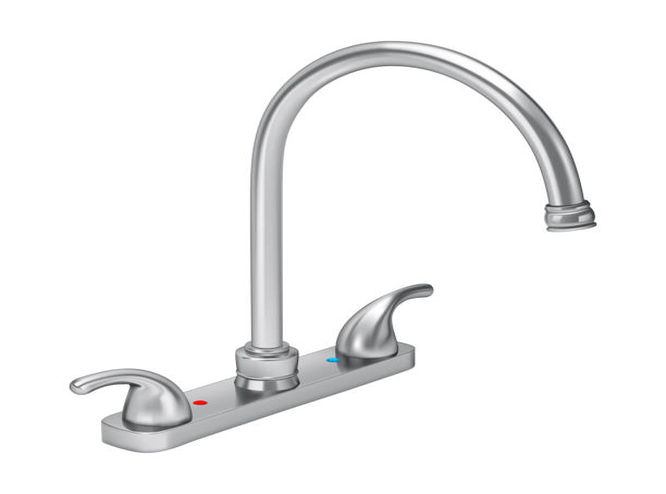
3. Pot filler faucets
Pot filler faucets are usually mounted on the wall (over the cooker) or near a stove or cooker. They carry jointed and flexible arms that allow them to be pushed back and out of the way or pulled forward to fill a pot. This type of faucet is perfect for busy homeowners who cook a lot and wish to fill a large pot easily and conveniently.
Pros
- Long and flexible spout making it easy and convenient to use
- Variety of designs, finishes, and styles to choose from
- Easy installation
Cons
- Professional installation required
- Repairs tend to be difficult and costly
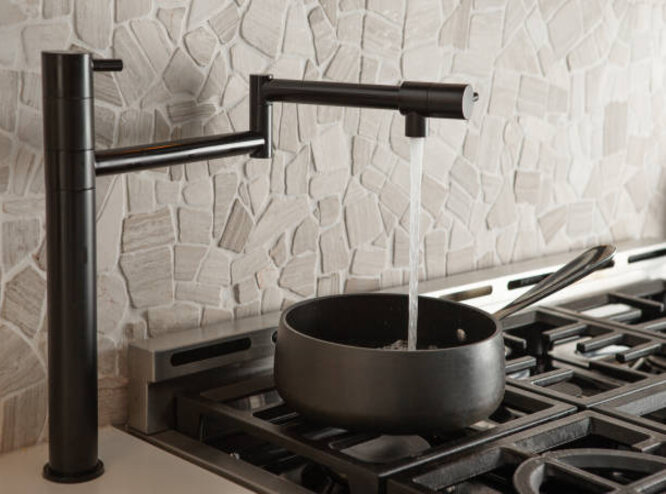
4. Bridge faucets
Bridge faucets are very similar to the traditional two-handle faucets. They are designed with two handles, one for cold and the other for hot water. These two handles are connected to the spout with a horizontal bar or a bridge, which gives the faucet a unique look. This faucet type is best for large sinks and creating a focal point.
Pros
- Aesthetically commanding
- A variety of styles and finishes are available to choose from
- Easy maintenance
Cons
- Must be connected to two separate valves, one for hot water and the other for cold water
- Steady usage might cause the spout to move around
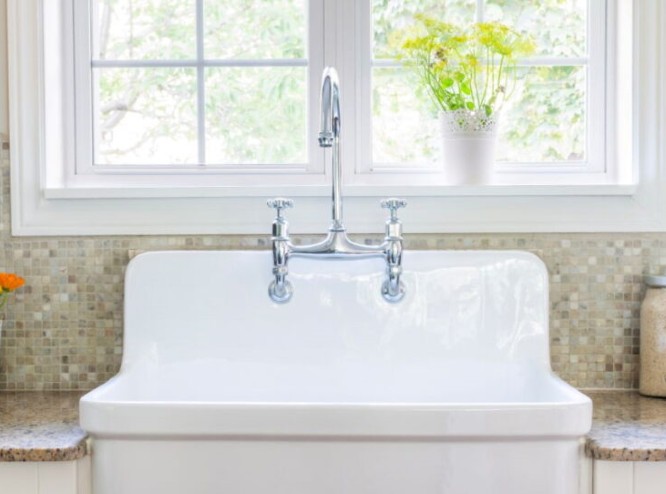
5. Gooseneck faucets
Gooseneck faucets are known for their unique arch which mimics the neck of a goose, which is where the name “gooseneck” spawns from. A gooseneck faucet makes washing large pots and pans and other kitchen work easily. This type of faucet is best for open sinks, and it works well for cleaning large objects.
Pros
- Offers a sleek and modern look
- Handles make it easier to adjust water temperature
- Variety of styles and finishes to choose from
- Easy operation
Cons
- Constant maintenance is required
- Not as affordable as other faucet types
- Costly repairs
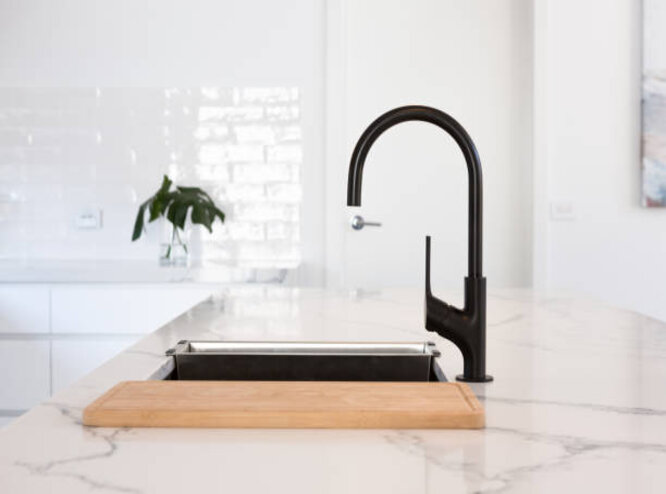
6. Straight spout faucets
The straight spout faucet is designed to reach out horizontally over the sink, remaining in a straight line. It is available in a variety of sizes, making it conducive for both large and small-sized sinks. Straight spout faucets are best for sinks that are tucked under the kitchen cabinets and do not have much height clearance.
Pros
- Sleek and stylish design, giving your kitchen a timeless look
- Their design makes cleaning them easy since there are limited crevices
Cons
- Prone to leakage due to constant usage
- Some users prefer faucets with more flexibility than straight spout faucets provide

7. Pull-out spout faucets
The pull-out spout faucet is a popular choice among homeowners because it offers both style and convenience. These faucets are designed to act both as a stationary faucet, a hose, and a handheld sprayer. This type of faucet is great for wide sinks as it can reach all edges and help if thorough washing is needed.
Pros
- Very easy and convenient to use
- Very versatile, it acts as a stationary faucet, a hose, and also as a hand-held sprayer
- Aesthetically appealing
Cons
- Installation is very tricky and must be done by a professional
- Costly installation
- High maintenance requirement
- Costly repairs
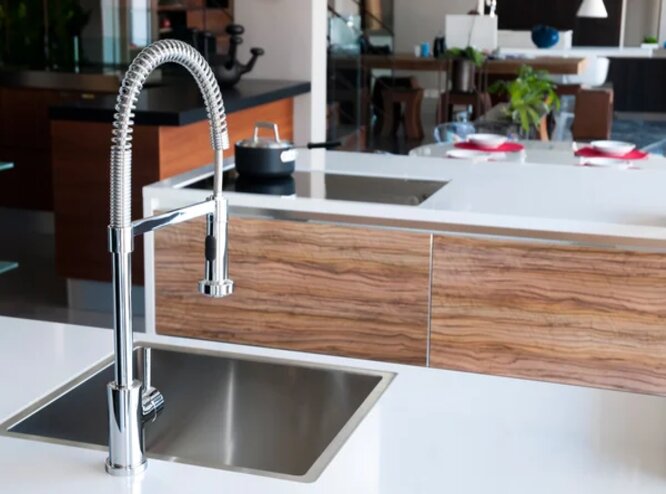
8. Touchless faucets
With different technologies flooding the market today, the touchless faucet can be a great addition to your kitchen. They are turned on with motion, hence the name “touchless faucet”. They only have one handle, which is used to control the temperature of the water.
Pros
- Reduces messes
- Boost hygiene, preventing you from accidentally touching a contaminated surface
- Easy operation
- Sleek aesthetics
Cons
- More expensive than traditional models
- Uses a sensor and requires electricity, which might increase your electricity bill a little bit
- Repairs are costly
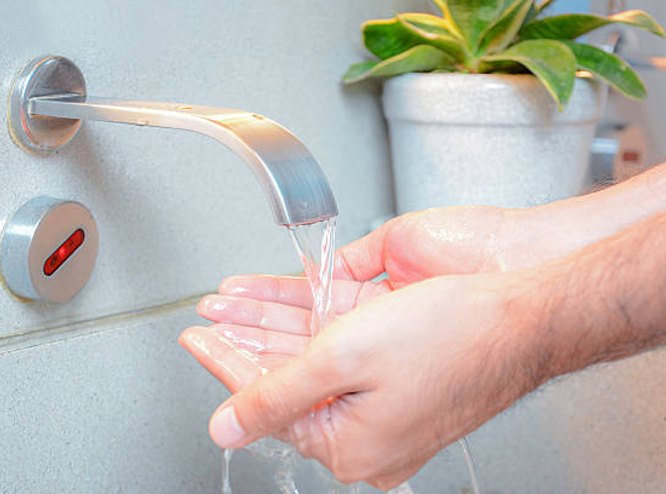
9. Touch-activated faucets
The touch-activated kitchen faucet is very similar to the touchless kitchen faucet. But instead of waving your hand across the sensor, you simply hit a button to turn it on and off. It also includes a handle that is used to control the temperature of the water.
Pros
- Wonderful aesthetics
- Easy and convenient operation
- Great for reducing water wastage
Cons
- Also a very costly option
- Repairs are also costly
- Requires power to operate as well
- Professional installation required
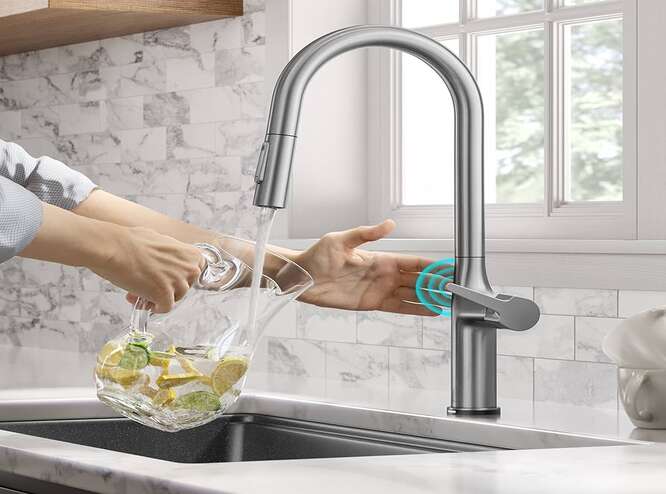
FAQs
What is a kitchen faucet?
A kitchen faucet is a fixture installed in a kitchen sink to help facilitate or control the flow of water for various tasks. This includes washing dishes, washing of hands, and cooking of food.
What is the most common type of kitchen faucet?
The one-handle faucet is one of the most common types of kitchen faucets.
Do all kitchen faucets fit all sinks?
No, they don’t. Some faucets require more than one hole, and others don’t. So, some sinks might be compactable with only a select few.
What is a faucet also known as?
A faucet is also referred to as a tap or a spigot.
Conclusion – Choosing a kitchen faucet
When it comes to choosing a kitchen faucet type, there is no shortage of options. But by focusing on what you need the faucet for, you will be able to narrow your choices down to get the best. Do you want a faucet that is convenient and easy to use? A touchless or a pull-out spout faucet may be your best choice.
Are you more concerned with getting a precise water flow or pressure? A double-handle faucet may be your best choice in this case. Are you looking for a faucet that can help make getting water for cooking easy? A pot filler faucet might be the best choice for you.
That aside, you must consider the setup of your sink. Remember that the faucet you choose has to be compatible with the sink as well. So make sure you confirm this before you purchase your faucet.
I hope this article was of help to you. You might also find this article on bathroom types to be helpful as well.
Thanks for reading.